10 best mesh Wi-Fi network systems
Wireless Mesh Network (WMN) is a communication network made up of nodes with a grid topology. It is also a form of wireless ad hoc network.
Speaking of mesh refers to a lot of connections between devices or nodes. Wireless wireless mesh networks often include client devices such as mesh, router routers and ports. The mobility of nodes is also less. If nodes continue or frequently move, mesh networks will have to spend more time updating than distributing data.
Mesh client devices are usually laptops, mobile phones and other wireless devices. Routers mesh forward traffic to and from ports, which may, but are not necessary, connected to the Internet. Today's article will introduce you to the best 10 mesh Wi-Fi networking systems in 2018.
10 best mesh Wi-Fi network systems
- Netgear Orbi High-Performance AC3000 (Best overall)
- Ubiquiti AmpliFi HD Home Wi-Fi System (Best choice for big houses)
- Google Wi-Fi (Best design)
- Asus Lyra System (simplest system)
- Linksys Velop Tri-Band AC6600 (Good in overall terms)
- TP-Link Deco M5 Mesh Wi-Fi System (The most affordable price)
- Gryphon Smart Mesh Wi-Fi System (Best security)
- Eero Home Wi-Fi System (Easiest setting)
- Tenda Nova Whole-Home Wireless Router System (Beautiful design)
- Luma Whole Home Wi-Fi (Best parental control feature)
Netgear Orbi High-Performance AC3000 (Best overall)
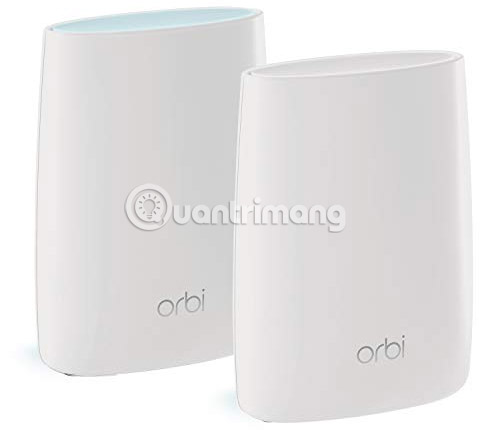
NETGEAR took the leading position in the list of Orbi-branded High-Performance AC3000, with a wide range of 465 square meters.
Owning a router and an identical satellite device, the Orbi system boasts extremely fast throughput, simultaneous transmission of MU-MIMO data and a number of custom features. It is a tri-band system with six internal antennas and can provide throughput rates of 1,266Mbps (400Mbps on 2.4GHz band and 866Mbps on 5GHz band). Its additional 5GHz band only communicates between the router and satellite, with speeds up to 1,733Mb / s. The router has three Gigabit LAN ports, one WAN port and one USB 2.0 port, and the satellite device has four Gigabit LAN ports and one USB 2.0 port, providing you with star-connection options.
Ubiquiti AmpliFi HD Home Wi-Fi System (Best choice for big houses)

Among Ubiquiti's devices, AmpliFi HD is the most powerful device. Made for large, multi-storey houses with thick walls and other obstructions, this device uses six high-density, wide-range antennas to accommodate up to 1858 in use. square meters. (Don't worry, these antennas are inside, so its appearance looks very nice). This system includes a router and two mesh plug-in points. Despite its size, it is a modern work of art. The front of the router has a full-color LCD touch screen showing time and date, you can touch the screen to display statistics such as current Internet speed (upload and download), IP address of router and WAN, as well as the current throughput speed.
This router has a single-core CPU, 802.11ac circuit that supports 2.4GHz and 5GHz Wi-Fi bands, providing aggregate speeds of up to 5.25Gbps. Similar to other systems, AmpliFi HD has a mobile application that allows you to manage settings, but it also allows you to separate radio bands and have a separate SSID, allowing you to manage traffic. easier. Unfortunately, there is no parental control feature on this device, but most users will not be bothered by this minus point.
Google Wi-Fi (Best design)
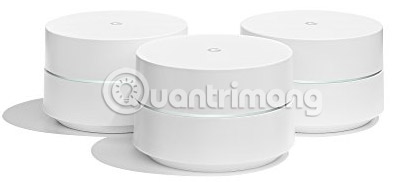
Google always designs everything as beautifully as possible. Google's Wi-Fi system is no exception. The system has three satellite devices that Google calls 'Wi-Fi points', with a total range of 418 square meters (each of which can cover 139 square meters). The points are shaped like hockey balls. Unfortunately, it lacks a USB port, which means you can't connect an external device.
Each point has a 4-core ARM CPU, 512MB RAM and 4GB eMMC flash memory, along with 802.1112 and 802.11s AC1200 (2X2) and mesh (mesh) circuits and Bluetooth radio. Google combines the 2.4GHz and 5GHz bands into a frequency band, which means you cannot designate the device for a frequency band, but conversely, it uses beamforming technology, automatically routing the device to the signal. strongest.
Google Wi-Fi wins the design, not only for hardware but also for software. The companion application (for Android or iOS) is very intuitive. It allows you to manage your point status, as well as setting up your network, test speed, port forwarding and more. Unfortunately, there is no parental control feature, but except for this point, Google Wi-Fi will help your family online quickly and easily.
Asus Lyra System (simplest system)
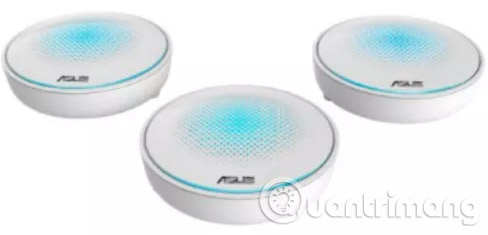
The Asus Lyra system comes with three hubs, like the other options on the list, and it links all these hubs under a single Wi-Fi name. The device also integrates technology that automatically switches between hubs when users move out of scope of this hub and switches to the scope of another hub. The system also operates with three separate bands. You can put your gaming system on a frequency band, another band for general Internet use and the remaining band for work. 802.11AC routers give you a transfer rate of up to 2,134 mbps.
Contains proprietary commercial grade encryption and protection provided by Asus AiProtection technology, as well as security options that allow you to set up parental control features. Finally, it is connected and controlled via an Asus app that is set up to work well with smart home products, so it will be a great additional device for any household. 'High technology'.
Linksys Velop Tri-Band AC6600 (Good in overall terms)
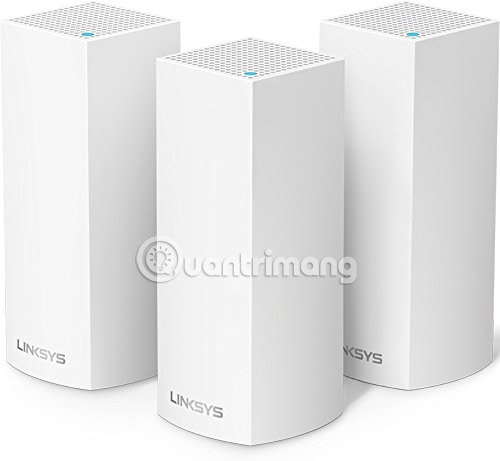
Linksys Velop Tri-band AC6600 includes three sleek white nodes, each about the size of a Jenga tower and beautifully designed, can be used as an indoor decoration instead of being hidden in one corner. Each node has a range of up to 186 square meters, so all 3 nodes will be enough for a house about 557 square meters, so this is a great option if you have a large house. (If your house doesn't have such a large area, you can buy individual nodes).
Each node is an AC2200 router with a maximum speed of up to 400Mbps on the 2.4GHz band and 867Mbps on each 5GHz band. Velop is one of the few systems that supports MU-MIMO data transfer, which helps transfer speeds faster. It also offers a lot of customization features in the mobile application, including parental control, device priority and guest network connectivity.
TP-Link Deco M5 Mesh Wi-Fi System (The most affordable price)
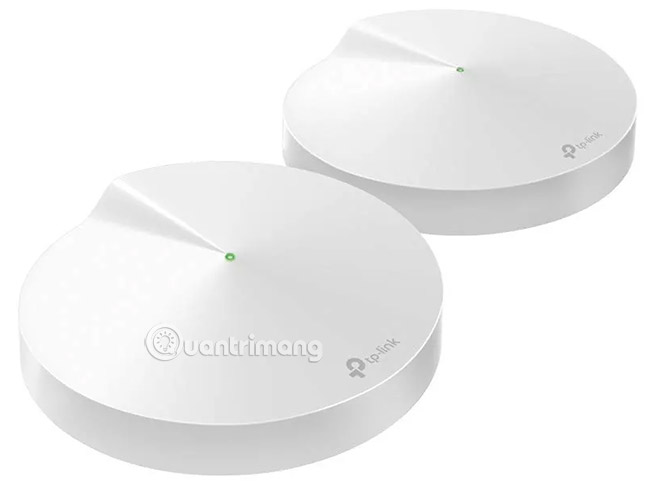
If you want to save a bit of money and still enjoy the benefits of Wi-Fi mesh, the Link Deco M5 is the perfect choice. Quick and easy setup via downloadable smartphone application. The device uses Bluetooth 4.2 connectivity, so the hardware can quickly connect to your smart device. It takes less than 10 minutes to set up and run. Once set up, the system can generate signals that touch almost every corner of the house or office (range up to 353 square meters). Within that range, the system can allow up to 100 devices to be connected at the same time.
Ideal for high speed Internet packets up to 500Mbps, the system uses Adaptive Routing technology to find the best connection for each device. Beamforming and MU-MIMO (multi-user technology, multiple inputs, multiple outputs) also contribute to increase signal strength. Connected via Ethernet cable, each sub-device provides two gigabit Ethernet ports, USB-C power and LED indicators for device status. Families with young children also appreciate the built-in parental control feature of this system. By creating a personal profile for each user, parents can set filters, limit the time and block websites they don't want their children to access.
Gryphon Smart Mesh Wi-Fi System (Best security)
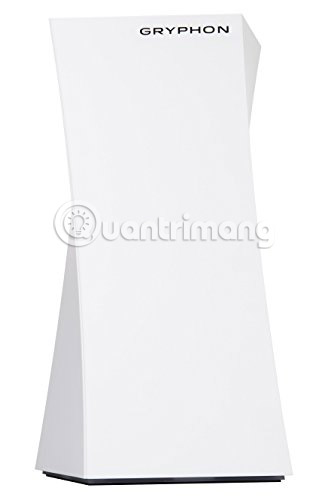
Keeping all the devices in the network safe from security holes, the Smart Mesh Wi-Fi Gryphon system is really worth it. Today, everything from light bulbs to cameras or washing machines is connected online. Each connected device creates a security threat and that's where Gryphon works. Combining AI-based intrusion detection and ESET's malware protection, Gryphon 'oversees' all your electronic devices. The malware filtering feature from incoming data streams along with enterprise-class security will keep unwanted files and websites from affecting users. If a security threat is detected, the relevant device will be quarantined from the network until the problem is resolved.
Users can manage all these protection features through a Gryphon smartphone application. The app allows any owner to review currently connected devices and browsing history. The application also supports quick installation, helping you online within minutes. In addition, the above smartphone application also includes parental control features to create a safe browsing environment for children. Each child device in Gryphon can cover up to 279 square meters. The two sub-devices in Gryphon are synchronized with each other, creating a true mesh system for fully connected use over a 557 square meter range.
Eero Home Wi-Fi System (Easiest setting)
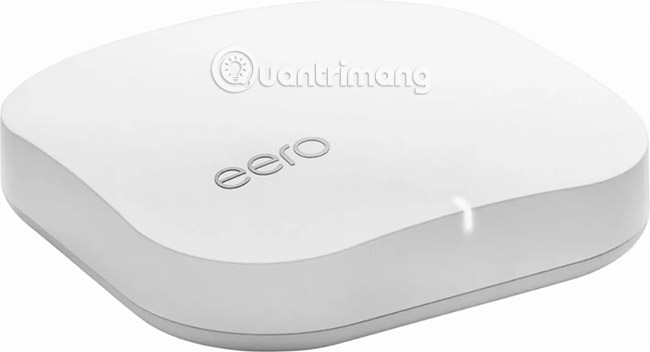
The common feature on almost all Wi-Fi mesh systems is their ease of installation, but setting up the Eero is even easier than you imagine. The production company claims you will only need a few minutes to set up with help from the mobile application. All you need to do is connect it to the modem via the supplied Ethernet cable, wait for the indicator light to turn blue and follow the on-screen instructions. Once you're done setting up, the application is also useful in testing Internet speed, network management, creating guest networks and more.
Eero's design is also commendable. After all, it was named after the famous industrial architect and designer Eero Saarinen. Three identical units (one router and two satellites) size 4.75 x 4.75 x 1.34inch (12 x 12 x 3.5cm). Inside is a 1GHz dual-core CPU with five Wi-Fi AC1200 antennas and circuits, all of which contribute to stable throughput speeds.
Tenda Nova Whole-Home Wireless Router System (Beautiful design)
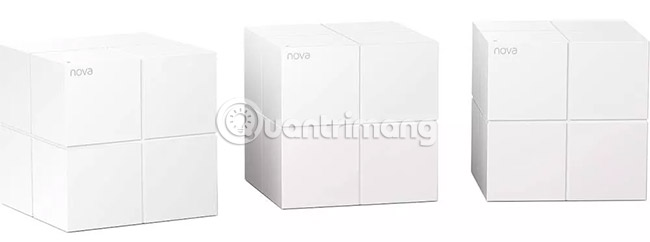
With Wi-Fi coverage of up to 557 square meters, Tenda's system is great for large houses (although it can be difficult for medium-sized offices). Like the other options on this list, this system will seamlessly connect like a Wi-Fi network, but it uses truly unique technology to help focus those connections on all devices. suffer at the same time. This technology is called Wave2 MU-MIMO along with Tenda's excellent beamforming technology, focusing on transferring energy to room devices, giving you almost 'unbeatable' connectivity to the Wi system. Your-Fi.
The system also includes a network optimization technology, maintaining the integrity of the system, even if a unit has a problem. If you disconnect a unit, it will automatically search and connect to another nearest unit. In addition, it is designed to not require special settings, giving you simplicity along with an easy-to-understand status LED.
Luma Whole Home Wi-Fi (Best parental control feature)
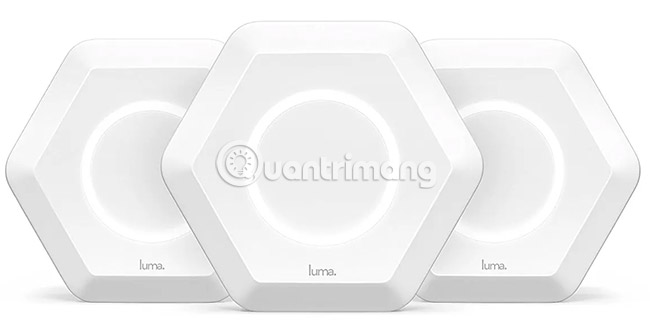
Quick Wi-Fi and simple setup may sound appealing, but if you have a home full of children, you know that can also be dangerous. Fortunately, Luma has a lot of parental control features, so you don't have to worry too much about kids anymore. In the settings, accessed via the mobile app (but not supported on the desktop), you can set content filtering policy with 5 ratings: Unrestricted, R-rated, PG -13, PG and G. Then you can add users and assign them access levels. There is also a handy Pause feature that allows you to freeze Internet access on the entire network.
In addition to parental control, Luma also provides solid performance, thanks to three modules, each containing an 802.11ac router, a quad-core processor and two radio bands (2.4 GHz and 5GHz). They are AC1200 routers with a maximum speed of 300Mbps on the 2.4GHz band and 867Mbps on the 5GHz band. Its automatic band transfer feature directs traffic to the bandwidth in the most efficient way, giving you the fastest Wi-Fi speed. In general, this is a simple way to get a strong Wi-Fi signal and still allow you to maintain control over children.
Above are suggestions for the best Wi-Fi mesh systems at the moment. Hope they will be useful for you to decide which system to choose for your family. Wish you can choose the product you like!
See more:
- 8 best long-range Wifi routers
- Notable indoor network devices at IFA
- 8 best Wifi security routers
You should read it
- NETGEAR Orbi review: One of the most powerful mesh router
- 4 best models of Mesh router for increasing WiFi wave 2020
- What is the Wi-Fi Mesh system? How does it work?
- Linksys MR8300 - Mesh Mesh Wi-Fi for advanced users
- What is Wifi Mesh system? Why should you use Wifi Mesh?
- The best 10 Wi-Fi Extender today
- Learn about 5G NR router and D-Link's WiFi Exo router
- Powerline adapter or mesh WiFi is the best choice for your home?
May be interested
- Learn about 5G NR router and D-Link's WiFi Exo router
 at the ces 2019 technology show, d-link introduced a series of new, smart exo mesh-enabled wi-fi routers and mcafee security suites. d-link also introduced its first 5g router.
at the ces 2019 technology show, d-link introduced a series of new, smart exo mesh-enabled wi-fi routers and mcafee security suites. d-link also introduced its first 5g router. - Laptops that support DirectX 11 were first sold
 mesh computers has just released the product, which it claims is the first commercially available mesh edge dx laptop to support directx 11 (dx11) processing.
mesh computers has just released the product, which it claims is the first commercially available mesh edge dx laptop to support directx 11 (dx11) processing. - Upgrade wireless network system
 common universal wi-fi network is not chosen by enterprise (dn) as the main means of connection ...
common universal wi-fi network is not chosen by enterprise (dn) as the main means of connection ... - Introducing the Windows Live Mesh 2011 application
 according to recent conflicting information, microsoft is still hesitating about the fate of live mesh / sync synchronization service based on the cloud technology platform ...
according to recent conflicting information, microsoft is still hesitating about the fate of live mesh / sync synchronization service based on the cloud technology platform ... - What is Mesh WiFi? How does Mesh WiFi work?
 how does wifi mesh work and how is it different from a traditional wifi extender? let's find out right away.
how does wifi mesh work and how is it different from a traditional wifi extender? let's find out right away. - Live Mesh and security related
 introducing security issues in 'cloud computing' in general, live mesh in particular and the mechanisms microsoft created to protect your 'meshed' devices and your data.
introducing security issues in 'cloud computing' in general, live mesh in particular and the mechanisms microsoft created to protect your 'meshed' devices and your data. - Windows Live Mesh: Windows online for everyone
 'redmond giant' has just launched a test of a new, online service about its scope of operation and purpose: windows live mesh, a service similar to the online operating system, users can connect and synchronize data from many different devices.
'redmond giant' has just launched a test of a new, online service about its scope of operation and purpose: windows live mesh, a service similar to the online operating system, users can connect and synchronize data from many different devices. - Robotic robot with wire mesh construction
 the construction robot was assigned the task of knitting steel mesh for concrete casting of the smart house built with 3d printing technology in switzerland. and it has done a good job.
the construction robot was assigned the task of knitting steel mesh for concrete casting of the smart house built with 3d printing technology in switzerland. and it has done a good job. - The Linux Network Administration test has the answer P5
 the following linux operating system quiz of network administrator will give you lots of useful information around this topic. please try your best.
the following linux operating system quiz of network administrator will give you lots of useful information around this topic. please try your best. - The Linux Network Administration test has the answer P6
 in order to help readers strengthen their knowledge of linux operating system, in the test below, network administrator will send you to read the multiple choice questions very interesting for you to try.
in order to help readers strengthen their knowledge of linux operating system, in the test below, network administrator will send you to read the multiple choice questions very interesting for you to try.










 5 settings need to change right on your new router
5 settings need to change right on your new router 8 best 802.11n routers in 2018
8 best 802.11n routers in 2018 Top 7 cheap Wifi routers in 2018
Top 7 cheap Wifi routers in 2018 How to find the default IP address of a Belkin router
How to find the default IP address of a Belkin router 11 best long-range Wifi routers 2018
11 best long-range Wifi routers 2018 The best 10 Wi-Fi Extender today
The best 10 Wi-Fi Extender today